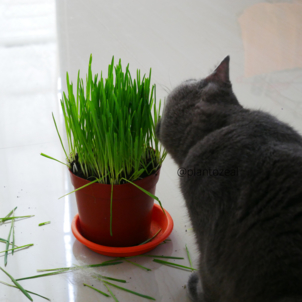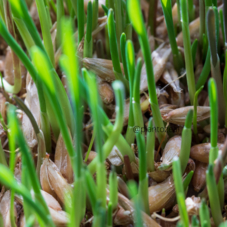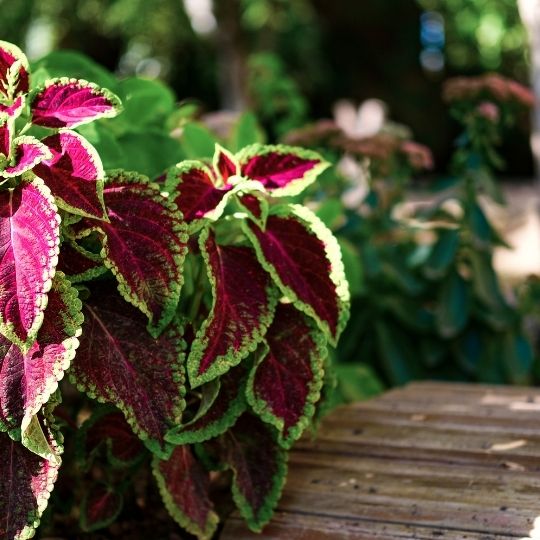
First of all, introduce yourself to the nature of cat grass. Then we will read tips on how to grow and care for cat grass. Cat grass is a mix of grasses that are grown from seeds from plants such as wheat, barley, oats, and rye. This is not the same as the grass on your lawn, which may contain pesticides. We grow cat grass indoors, especially for pets to consume. Which is safe and healthy for people and animals. It is a popular houseplant that can serve as a natural way to add vitamins to your pet’s diet.
How to Grow Cat Grass from Seeds
First of all, introduce yourself to the nature of cat grass. Then we will read tips on how to grow and care for cat grass. Cat grass is a mix of grasses that are grown from seeds from plants such as wheat, barley, oats, and rye. This is not the same as the grass on your lawn, which may contain pesticides. We grow cat grass indoors, especially for pets to consume. Which is safe and healthy for people and animals. It can serve as a natural way to add vitamins to your pet’s diet.
Best way of How to plant Cat grass from Seeds
If you want to Know how to care for cat grass and how to grow it from seeds red these steps. To grow your own cat grass, you can buy cat grass kits at your local pet store. Check out the following steps below to grow your own cat’s grass from seeds of the oat, barley, rye, and wheatgrass:
- Plant your seeds. Directly sow the seeds into the soil (whether they are growing indoors or outdoors), about a quarter of an inch deep. When arranging the seeds in rows, ensure they are one inch apart from each other. You can grow cat grass indoors all year round, but you should only plant it outside in the spring after the threat of frost has passed.
2. Germination. Make sure the soil is moist when growing indoors. Wrap your planting pot partially in plastic wrap and keep it in a warm, dark place. Your cat grass seedlings should begin sprouting within two to three days.
3. Direct sunlight is recommended. Cat grass requires lots of sunlight to grow. Your cat grass should receive direct sunlight outside, and if growing indoors, place it near a windowsill with full sun.
4. Firm up the soil. Maintain even moisture levels throughout the season. Neither overwater nor underwater your plants. Overwatering can damage the roots of cat grass
Steps of how to care for cat grass
If your pets or other animals chew on your cat grass, there are several steps you can take to ensure that it continues to grow: There are some steps on how to care for cat grass
- Cut it back. – Cat grass is nibbled by animals, but it’s best to trim at least one inch every other week to prevent the leaves from flopping over.
- Sow regularly.- Plant fresh cat grass seeds every two weeks.
- Ensure the grass is pest-free.– Aphids, slugs, and white worms, among others, should not be present in your grass.
4. Use mulch. –Keeping weeds down by mulching your grass can prevent them from competing with your grass’ natural resources, which can inhibit its growth.
5. Temperature- Maintain right amount of temperature is one of the most important step on how to care for cat grass. Keeping your cat grass at the right temperature will help it stay healthy and grow as long as possible. 16 to 19 degrees Celsius is the ideal temperature for cat grass. You simply need to consider where to place your cat grass.
6. Ventilation- Place your cat’s grass away from cold drafts, but in a well-ventilated area. Your cat grass needs to be planted in a place where it can grow at a consistent temperature and where your cats won’t be disturbed while they are enjoying their treat
7. Avoid overwatering. – It is the last step on ho w to care for cat grass so read carefully. To prevent soaking your plants, water your cat grass only after the top of the soil has dried. Overwatering can cause mold to grow.
How to grow cat grass without soil
Here are the followings steps on how to grow and care for cat grass without soil 1.Collect the materials: To grow cat grass without soil, you will need:
- Small glass jar or plastic container
- cat grass growing stones
- unbleached Paper towels or coffee filters
- Seeds for growing cat grass
- Water that has been filtered
2.Seeds must be prepared: Rinse the cat grass seeds in water and soak them overnight.
3.Preparation of the jar or plastic container: Add about 2/3 full of growing pebbles to the container. Place a coffee filter or paper towel on top of the stones. Spread a thin layer of seeds over the paper or filter.

4.Add a bit of water: Pour water into the container slowly, so that the paper and seeds are slightly submerged. Ensure that the seeds are not completely covered to the point where they float.
5. Keep the pot in medium sunlight: Neither too much darkness nor direct sunlight should be present in the area. Moisten the stones and paper regularly to prevent them from drying out.
6. It should only take a couple of days for your seeds to sprout, and your cat should be able to enjoy them within ten days!
7. As your cat grass roots grow, you can stop maintaining a high level of water. Keep the roots moist at all times.
Also read about how to grow houseplants from different types of seeds
FAQs
Yes, Dogs can consume cat grass. Cat grass can be fed directly from the pot to your dog, clipped, or added to its food.
Your dog will be healthier if he nibbles cat grass, but don’t feed him too much of it. Consult your veterinarian if your dog is eating too much cat grass. The cat grass is safe for dogs. It can relieve digestive issues like diarrhea and minor gas. As your dog chews on it, it also contains lots of fiber, which helps keep his teeth clean.
Wheatgrass is actually a type of cat grass, so there is no real difference between wheatgrass and cat grass. Cat grass can also be produced from grain seeds such as oat, barley, rye, flax, bluegrass, and fescue. These are all grasses that are commonly used to produce cat grass.
Dactylis glomerata is the Scientific name of cat grass.
